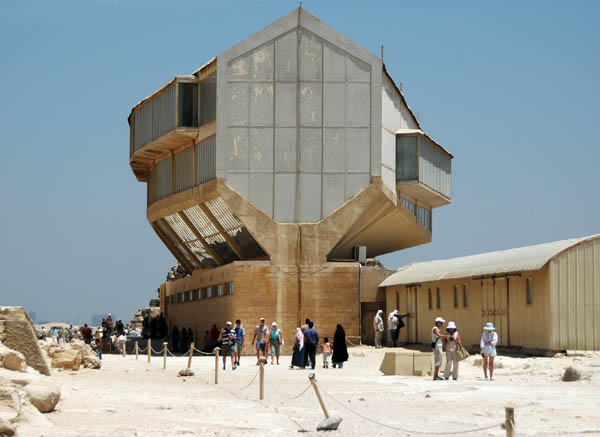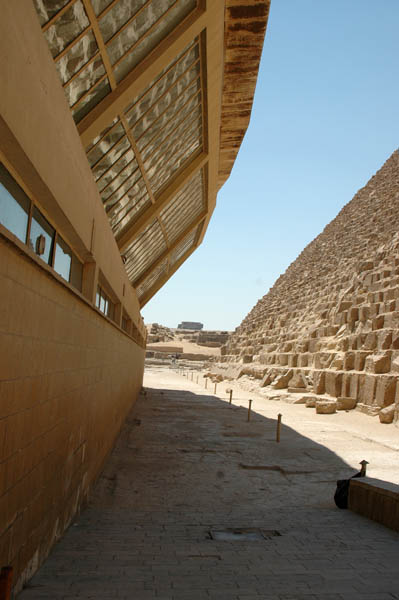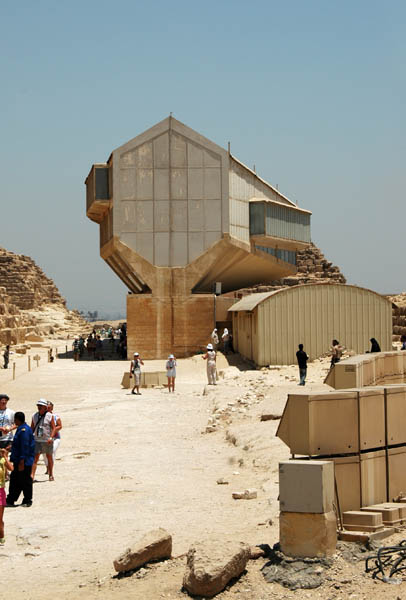 The two southern boat pits were discovered in 1954, during cleaning work, by the Kamal el-Mallakh
and Zaki Nur. The eastern pit was covered by a roof of 41 limestone slabs weighing between 17 and 20 tons
each, the largest is about 4.8 meters long. The three westernmost of these stones were much smaller than the others and
have been interpreted as keystones. The pit measures about 32.5 meters in length. When one of the slabs was raised from
the eastern pit, the planking of the great boat was seen, completely dismantled, but arranged in the semblance of its
finished form.
The two southern boat pits were discovered in 1954, during cleaning work, by the Kamal el-Mallakh
and Zaki Nur. The eastern pit was covered by a roof of 41 limestone slabs weighing between 17 and 20 tons
each, the largest is about 4.8 meters long. The three westernmost of these stones were much smaller than the others and
have been interpreted as keystones. The pit measures about 32.5 meters in length. When one of the slabs was raised from
the eastern pit, the planking of the great boat was seen, completely dismantled, but arranged in the semblance of its
finished form.
The cedar boat now on display was originally dismantled into 1,224 individual parts. On top of the wood was a layer of mats and ropes, an instrument made of flint, and some small pieces of white plaster. The prow of the boat, a wooden column topped by a round wooden disk, was found at the western end of the pit. This column was connected to two long wooden pieces that extended along the bottom of the pit. Most of the wooden parts had been tied together with ropes. Also found inside the pit were many other items, such as twelve oars, each mad from a single piece of wood, fifty-eight poles, three cylindrical columns and five doors. In total, there were thirteen layers of materials consisting of 651 artifacts ranging in size from 10 centimetres to 23 meters.
The boat was removed, piece by piece, under the supervision of Ahmed Youssef Mustafa, the master restorer who worked on Hetephere's funerary furniture. It is 43.3 meters (142 feet) long and made of Lebanese cedar wood and some acacia. Its displacement was 45 tons. The maximum draft is 1.48 meters (5 feet). It is 5.9 meters wide. The separate parts of the boat had numerous U-shaped holes so that the boat could be 'stitched' together using ropes made of vegetable fibres. Interestingly many of the boats planks were marked with signs for prow, stern, port and starboard. Nevertheless it took Mustafa some ten years to completely reassemble the boat. That work was not completed until 1968.
The boat's prow and stern are in the form of papyrus talks, with the stern one bent over. Therefore, it is essentially a replica of a type of papyrus reed boat, perhaps dating back to the Predynastic Period. During the Old Kingdom, it is not difficult to find many objects simulating the Egyptian's earlier construction material in more durable material. It has a cabin, or inner shrine, which is enclosed within a reed-mat structure with poles of the same papyrus-but form that we see in the canopy of Hetepheres. It also has a small forward cabin that probably was for the captain. Propulsion was by means of ten oars, and it was steered using two large oar rudders locate din the stern. There was no mast, and therefore no sail, and the general design of the boat would have not allowed it to be used other than for river travel.

